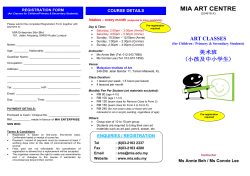
WATER-BASED PAINTS OF OLD
WATER-BASED PAINTS OF OLD By Loree Wallace Photography By: Cooper PAINT HAS HAD A VERY LONG HISTORY AS IS EVIDENT IN CAVE PAINTINGS AND EGYPTIAN HIEROGLYPHS, AND IN THE COLOURFUL 200-YEAR-OLD ARMOIRE YOU PURCHASED WHILE ON VACATION IN RURAL QUEBEC. In the last issue, I discussed traditional oil-based paints used by our forefathers. Recall that a paint is generally made up of three main ingredients: pigment(s), a binder (this holds the pigment particles together and also binds them to the surface to which the paint is being applied), and a thinner (water or spirits) which allows for easy application and spreading of the pigment and binder mixture. The thinner will evaporate as the paint dries leaving behind a film of the pigments and binder. Some of the water-based paints are also known as “Distemper”, “Limewash”, “Tempera”, or “Milk Paint”. You probably recognize these paints of yesteryear and think of them as oldfashioned paints which no longer have a place in modern décor. On the contrary! Milk Paint produces a much-sought-after dead-flat to matte finish (produced with 100% environmentally sound ingredients) that appeals to many people. This type of paint also has unique properties, one of which is its high porosity which is valued by restoration enthusiasts who understand that some surfaces, like lime plaster walls, need to breathe. We now realize how debilitating damp related issues, such as mould and rot, can affect houses and the people who live in them. DISTEMPER: Also called “soft-distemper” it is made of a whiting (chalk, or calcium carbonate) and size (a glue made from animals). Pigments can be added to make a variety of colours. This matte sheen paint was used only inside, often on ornamental plaster and ceilings, as it could not be exposed to water. It was not washable -- in fact, washing it would remove it. This economical paint was often only a temporary décor solution used to give a blush of colour to new lime plaster walls whilst they were setting. Since it took months -- even a year -- for the plaster to carbonize (cure), this breathable paint would allow the process to continue allowing you to live in your home with a hint of colour until you could hang your wallpaper, the reason lime plaster walls were created in the first place. Some recipes called for the addition of some oil and an emulsifier such as “borax” to create a washable Distemper. 10 edifice number ten © Copyright 2009 Edifice Old Home Magazine All Rights Reserved TEMPERA: This is one of the oldest paints used; it is found within tombs, temples and palaces. It was prepared using pigments, egg yolk and water. The binder in this case was the egg yolk and we can understand why it worked so well; have you ever tried to wash a dish that has dried egg yolk on it? LIMEWASH: This traditional paint was made of pigments, lime and water. Simple whitewash was lime mixed with water. Various limewash recipes could result in paint coatings that were either extremely hard or somewhat flexible depending on the ratio and type of ingredients. This porous paint was used inside and outside the home to, surprisingly, provide a strong paint in a variety of colours. Some recipes, for instance, called for animal fat (tallow) which could be added to make the paint somewhat resistant to water (and subsequently less porous). It was primarily used outside for this reason, and since the fat doesn't truly dry, the limewash would easily rub off onto clothing. Alternatives to tallow were other oils and waxes. Another ingredient found quite useful was casein (protein from milk), which increased the binding properties and adhesion quality of the paint. MILK PAINT: As the name implies, milk is one of the ingredients of milk paint. When mixed with lime and some pigments a paint is produced that can be used on a variety of surfaces. The protein (casein) within the milk acts as a binder and the water portion of the milk becomes the thinner. There are many different recipes, including some that called for chalk and or clay to be added. Remember, it is the lime that plays a big role in both the Limewashes and Milk Paint. When lime dries it becomes very hard (as it converts back to limestone!) and the result is almost like having a thin layer of reconstituted stone on your project. Another additional benefit attributed to lime is that mould and mildew do not grow on this slightly alkaline material. Homestead House Paint has Milk Paint available in over 50 colours; how ever, the choice is limitless as the colours can be intermixed to achieve the desired colour. To protect certain projects and augment the patina on furniture, Homestead House Paint has various products available for purchase such as the Hemp Oil Wood Loree Wallace Finish, Beeswax and a Satin Sheen Homestead House Paint Co. Varnish. www.homesteadhouse.ca These paints were inexpensive and easy to make on the homestead. Milk paint was used in the home, on furniture, and outside. Sometimes oil would be mixed into the paint or be applied after the paint had dried. This was done to seal the porous milk paint surface on furniture or exterior applications where water resistance was required. Interior walls, however, would not be sealed. Milk paint is used today on a variety of items and its use continues to grow. When used on a porch or fence or grayed wood, for instance, it soaks into the wood fibers to never peel away as modern paints ultimately do. It can also be applied to any porous surface such as plaster, wood, masonry, etc. Reproduction furniture makers use milk paint to achieve an authentic appearance. It is truly unique. Today milk paint is produced in powdered form to be simply mixed with water. © Copyright 2009 Edifice Old Home Magazine All Rights Reserved e edifice number ten 11
© Copyright 2025











